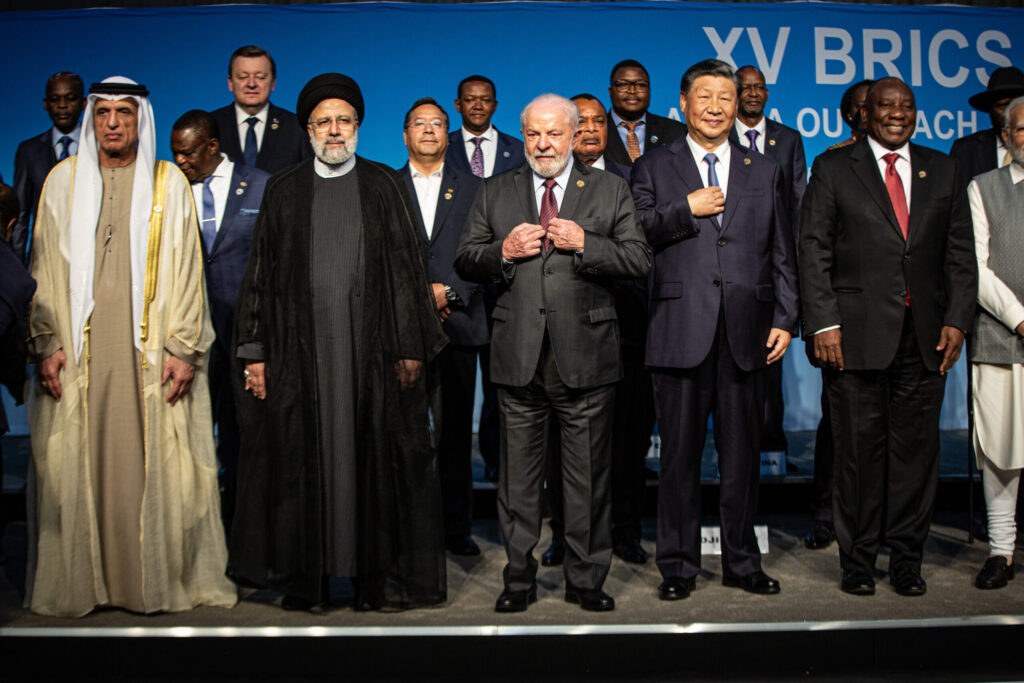Analyses / Energy and Raw Materials
30 May 2024
The Brics+: Towards Unlimited Domination of Commodity Markets?

The acronym BRIC, coined in 2001 by Jim O’Neill to highlight the economic potential of Brazil, Russia, India, and China, became BRICS in 2011 with the inclusion of South Africa, and BRICS+ in August 2023. The addition of new members—Saudi Arabia, Iran, the United Arab Emirates (UAE), Egypt, and Ethiopia—has bolstered the group’s economic and political influence on the global stage. BRICS+ now represents 46% of the world’s population and 29% of global GDP.
However, it is in the energy and metal commodities sectors that the group could become a truly dominant bloc. With the inclusion of some of the largest exporters or holders of hydrocarbon reserves (oil and gas), the BRICS+ positions itself as a serious rival to OPEC. In the metals sector, Brazil, China, Russia, and South Africa were already major players, but the inclusion of Saudi Arabia—with its ambitions to become a mining powerhouse—and the potential future inclusion of Indonesia, the Democratic Republic of Congo (DRC), or Chile, further strengthens their position.
As control over raw materials becomes increasingly strategic in the context of global decarbonisation, and energy and digital transitions, a new bloc centred on commodities could emerge around BRICS+. Could we then witness the birth of a new alliance that leverages raw materials as a diplomatic tool in a world of climate, economic, and geopolitical insecurities?
The Expansion of BRICS+ in the Global Economy
BRICS+ is characterised by economic development driven by state-led initiatives, a significant public sector, and integration into globalisation through trade in raw and processed natural resources. The group accounts for 25% of global exports, with G7 countries remaining its primary trading partners. In 2023, BRICS represented 30% of global GDP and 46% of the world’s population, compared to 45% and 10%, respectively, for the G7. However, the original BRICS countries have surpassed the G7 in terms of GDP measured by purchasing power parity (PPP), holding 31% compared to the G7’s 29%—a sign of their economic dynamism and the relative decline of G7 economies.
The expansion of BRICS+ strengthens its economic and demographic weight on the international stage, as the group seeks to play an increasingly significant role in global affairs, partially challenging the multilateral system established in 1945. In 2014, for instance, the group established its own institution, the New Development Bank, with $100 billion in capital aimed at financing infrastructure projects and supporting member countries in times of liquidity crises. These initiatives provide an alternative governance model to the traditional multilateral system, particularly for countries in the so-called Global South.
The inclusion of Saudi Arabia and the UAE has enhanced the group’s energy influence, with BRICS+ now accounting for 43.1% of global oil production and 44% of reserves, as well as 35.5% of global gas production and 53% of reserves. China’s support for the potential inclusion of Nigeria and Kazakhstan signals a desire among some members to further bolster BRICS+’s energy clout.
In terms of food commodities, BRICS+ produces 42% of the world’s wheat, 52% of its rice, and 46% of its soybeans, playing a key role in global food security. The group thus holds a dominant and central position in several critical commodity markets: food, energy, and increasingly, metals.
BRICS+: A Dominant Position in the Metals Market
As metals become central to the low-carbon and digital transitions, BRICS+ now holds a dominant position in both the production and global reserves of key critical metals such as platinum group metals, rare earth elements, and copper.
By boosting their production and developing their mineral potential, each BRICS+ country aims to secure its supply of critical metals and strengthen its position as a producer. BRICS+ offers each member nation the opportunity to enhance bilateral relations for these strategic materials, bypassing traditional international trade channels. For China, this strategy ensures the sustainability of its production of low-carbon technologies such as batteries, electric vehicles, and solar panels. Member countries are also diversifying investments to strengthen their presence in other strategic metals they do not produce. For instance, Saudi Arabia is developing its mining industry, attracting foreign investments, launching partnerships, and aspiring to become a regional hub for energy and metal trade. It has invested in the Brazilian group Vale to secure lithium and nickel and has initiated titanium sponge production—key materials for the defence and aerospace industries.
In addition to their abundant resources, BRICS+ countries stand out for their restrictive export policies on strategic metals. All members have implemented various restrictions, ranging from taxes to outright bans and licensing controls. In December 2023, China banned the export of rare earth processing and refining technologies to secure its technological advantage. China extracts 60% and processes 90% of these critical metals, essential for permanent magnets found in wind turbines, electric vehicle motors, and smartphones—key components of the modern economy.
A coordinated approach to export restrictions by BRICS+ could pose significant risks to the security of critical metal supplies, vital for the energy and technological resilience of Europe, the United States, and Japan.
Is the Formation of a Metals Bloc Credible?
The BRICS+ nations are strengthening their ties through cross-investments and partnerships, forming a particularly dominant group in the metals and transition technologies sector. The inclusion of the UAE and Saudi Arabia, with their significant financial resources, increases the group’s investment capabilities. Saudi Arabia has established partnerships with Brazil (Vale), China (Human Horizons), and Egypt. Meanwhile, China aims to control various stages of low-carbon value chains, from metal production to the construction of low-carbon technologies and refining processes. The group is partly organised around financial flows in strategic markets such as metals.
To become a true metals bloc, BRICS+ would need to incorporate countries like Chile, the Democratic Republic of Congo (DRC), and Indonesia, further consolidating their dominance in the metals market. The DRC accounts for 74% of global cobalt production and 55% of reserves, while Chile is a leader in copper and lithium markets. Although the DRC has expressed interest in strengthening ties with BRICS+, Indonesia has chosen to remain independent despite a formal invitation to join, adhering to its long-standing position of non-alignment. These discussions about membership, despite seemingly aligned economic interests, raise questions about the unity of the bloc.
BRICS+ countries aim to rival major Western economies and reform the international monetary system to challenge the dominance of the dollar. However, internal divergences limit their cohesion. Political regimes are heterogeneous, economic convergence is limited, geopolitical disagreements persist, and regional competition remains significant. Membership in BRICS+ is less about joining a cohesive bloc on the international stage and more about diversifying alliances. Contemporary international relations are marked by multi-alignment and transactional logic—alliances formed on a case-by-case basis. Saudi Arabia exemplifies this new diplomatic regime: while maintaining a strong and renewed partnership with the United States, the Gulf monarchy is also deepening its ties with China and BRICS+.
When it comes to metals, member countries’ interests align: controlling strategic metal production, regulating prices, maintaining a dominant position in the energy transition, and monopolising technology. This makes the formation of a mineral bloc, or at least a coordinated approach to extraction and trade policies, a credible possibility.
The risk of metal cartelisation by BRICS+ is prompting other players, particularly Europe, to consider how to secure their supplies. This is crucial for Europe, as the costs of the ecological transition largely depend on the price of raw materials. In response, the European Commission published the Critical Raw Material Act in 2023 to "support the development of domestic capacities and strengthen the sustainability and circularity of critical raw material supply chains." This reflects growing tensions in these markets and a recognition of the return of resource-related conflicts.
These tensions could provide Europe with an opportunity to develop its own mining industries, aligned with its sustainability standards. At the same time, Europe could export its environmental norms. Combined with a policy of resource efficiency and an effective recycling system, European mines could enhance supply security and reduce dependence on a potential BRICS+ metals cartel.

